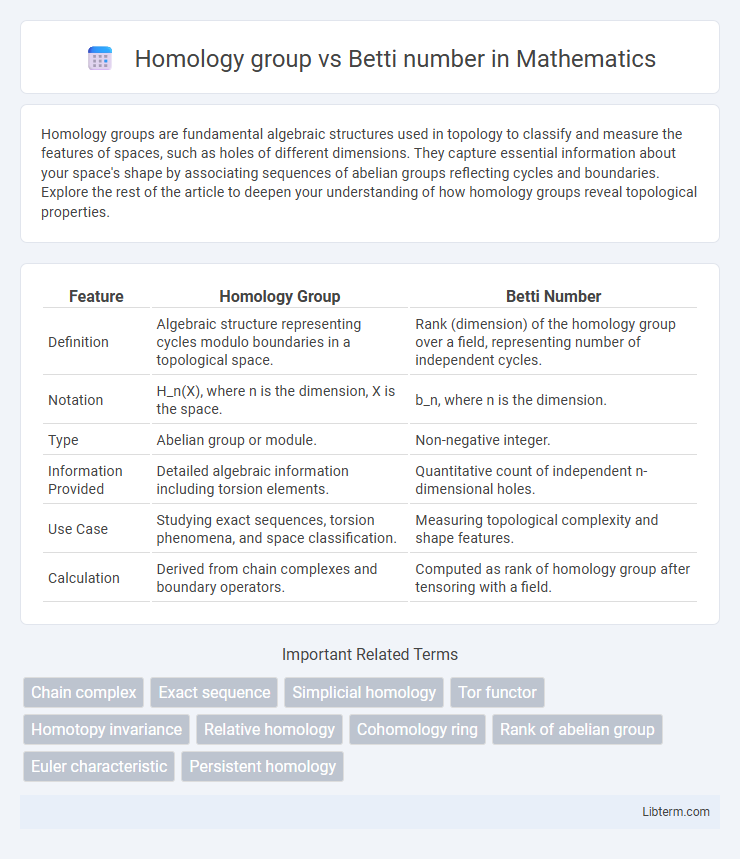Homology groups are fundamental algebraic structures used in topology to classify and measure the features of spaces, such as holes of different dimensions. They capture essential information about your space's shape by associating sequences of abelian groups reflecting cycles and boundaries. Explore the rest of the article to deepen your understanding of how homology groups reveal topological properties.
Table of Comparison
| Feature | Homology Group | Betti Number |
|---|---|---|
| Definition | Algebraic structure representing cycles modulo boundaries in a topological space. | Rank (dimension) of the homology group over a field, representing number of independent cycles. |
| Notation | H_n(X), where n is the dimension, X is the space. | b_n, where n is the dimension. |
| Type | Abelian group or module. | Non-negative integer. |
| Information Provided | Detailed algebraic information including torsion elements. | Quantitative count of independent n-dimensional holes. |
| Use Case | Studying exact sequences, torsion phenomena, and space classification. | Measuring topological complexity and shape features. |
| Calculation | Derived from chain complexes and boundary operators. | Computed as rank of homology group after tensoring with a field. |
Introduction to Homology Groups and Betti Numbers
Homology groups are algebraic structures that measure the presence of holes of different dimensions in a topological space, providing a way to classify and distinguish spaces based on their shape. Betti numbers are the ranks of these homology groups, quantifying the number of independent cycles or voids in each dimension. Together, homology groups and Betti numbers form fundamental tools in algebraic topology for analyzing the connectivity and structure of complex geometric objects.
Fundamentals of Algebraic Topology
Homology groups are algebraic structures used in algebraic topology to classify topological spaces based on their cycles and boundaries, capturing information about holes of different dimensions. Betti numbers are numerical invariants derived from the rank of homology groups, quantifying the number of independent cycles or holes at each dimension. These concepts are fundamental for analyzing the shape and connectivity properties of spaces through algebraic means.
Defining Homology Groups
Homology groups are algebraic structures that classify topological spaces based on their cycles and boundaries, capturing features such as holes and voids in various dimensions. They are defined via chain complexes and boundary operators that map chains of simplices to their boundaries, with homology groups being the quotient of cycles modulo boundaries. Betti numbers are the ranks of these homology groups, quantifying the independent cycles and providing a numerical summary of the topological complexity of the space.
Understanding Betti Numbers
Betti numbers quantify the rank of homology groups, providing a measure of the number of n-dimensional holes in a topological space. Each Betti number corresponds to the dimension of a homology group, with the first Betti number indicating the number of independent cycles and the zero-th Betti number representing connected components. Understanding Betti numbers enables the classification of shapes by their topological features, crucial in fields like algebraic topology and data analysis.
Relationship Between Homology Groups and Betti Numbers
Homology groups provide an algebraic structure that captures the topological features of a space, with each group corresponding to a specific dimension of holes or cycles. Betti numbers are defined as the ranks of these homology groups over a field, quantifying the number of independent cycles in each dimension. The relationship between homology groups and Betti numbers is fundamental in algebraic topology, as Betti numbers serve as numerical invariants that summarize the size and complexity of homology groups.
Calculating Homology Groups: Methods and Examples
Calculating homology groups involves using simplicial or singular homology techniques, where chains, cycles, and boundaries of topological spaces are analyzed to identify equivalence classes of cycles. Betti numbers arise as the ranks of these homology groups, representing the number of holes or independent cycles in each dimension. Algorithms such as boundary matrix reduction and persistent homology facilitate practical computation of homology groups in complex structures like simplicial complexes and cell complexes.
Computing Betti Numbers from Homology Groups
Betti numbers quantify the rank of homology groups, representing the number of independent cycles at each dimension in a topological space. Computing Betti numbers involves determining the rank of homology groups derived from chain complexes, which measure connected components, holes, and voids within the space. These computations play a crucial role in topological data analysis, enabling the characterization of shape features through algebraic invariants.
Topological Interpretation of Betti Numbers
Betti numbers provide a topological interpretation by quantifying the rank of homology groups associated with a given space, representing the number of independent k-dimensional holes. Each Betti number corresponds to the dimension of the k-th homology group, encapsulating essential features such as connected components, tunnels, and voids in geometric structures. This relationship enables algebraic topology to describe complex shapes and connectivity through homology, bridging discrete algebraic invariants and continuous topological properties.
Applications in Mathematics and Science
Homology groups provide algebraic structures that capture topological features such as holes and voids in various dimensions, enabling rigorous classification of shapes and spaces in algebraic topology. Betti numbers, derived from homology groups, quantify the number of independent cycles or holes at each dimension, serving as essential invariants in fields like differential geometry, data analysis, and computational topology. Applications in science include material science for porous structure analysis, biology for studying the shape of proteins and DNA, and machine learning for feature extraction in high-dimensional datasets.
Summary: Key Differences and Insights
Homology groups classify topological spaces by capturing information about their holes across different dimensions, providing a structured algebraic framework. Betti numbers quantify these homology groups by measuring the rank or number of independent cycles, indicating the count of various types of holes. The key difference lies in homology groups offering detailed algebraic structures, while Betti numbers serve as concise numerical summaries of topological features.
Homology group Infographic

 libterm.com
libterm.com